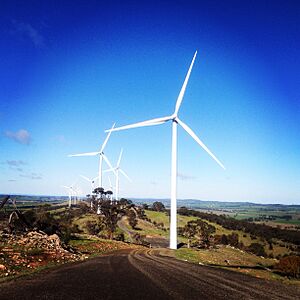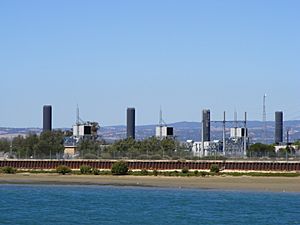Energy in South Australia facts for kids
South Australia is a big leader in making clean energy! It uses lots of wind and solar power to create electricity. The state also has natural gas and uranium, which can be used for energy, but nuclear power (from uranium) is not allowed in Australia. Gas is mostly found in the Cooper Basin and sent through pipelines to power plants.
South Australia has worked hard to become a "green energy" hub. Wind and solar power, including panels on rooftops, now provide most of the state's electricity. In December 2021, South Australia even ran entirely on renewable energy for six and a half days in a row! The goal is for South Australia to be powered only by clean energy very soon.
Contents
How South Australia Gets Its Electricity
Old Ways: Fossil Fuels
For a long time, South Australia got most of its electricity from burning coal. In 2002, all of its electricity came from fossil fuels, and some was even brought in from other states.
In the 1940s, the government took over the main power company and the electricity network. At first, power stations burned coal from other parts of Australia. But South Australia wanted to be more self-sufficient. So, in the 1950s, they opened a coal mine near Leigh Creek. They also built power stations near Port Augusta, like the Playford A and B stations, specifically to burn South Australian coal. The last big coal power station, the Northern Power Station, closed in 2016.
Since the 1950s, natural gas has also been used to make electricity. The biggest gas power area is near Port Adelaide. Here, large power plants like the Torrens Island Power Station and Pelican Point Power Station use gas to create electricity. Gas generators are also used for remote mining and some towns.
New Ways: Renewable Energy
After 2002, the South Australian government decided to switch from fossil fuels to renewable energy. They aimed for 15% of electricity from renewables by 2014, and 26% by 2020. This plan was very ambitious! It aimed to reduce pollution and rely less on electricity from other states.
Even though it was a big challenge, South Australia did great! By 2009, 20% of the state's electricity came from wind power. South Australia has become a leader in using renewable energy. It has some of the windiest and sunniest places in Australia, which is perfect for green energy.
The government mapped out the best places for solar and wind power. They found that areas near the old Port Augusta power stations were great for wind farms. Money was invested to help research and develop more green energy.
By 2017, sometimes renewable energy could power all of South Australia! However, these new energy sources didn't always make the grid stable. So, gas power plants sometimes had to be turned on to help keep the electricity flowing smoothly. To fix this, special equipment called synchronous condensers were installed. These help keep the grid stable even with lots of wind and solar power. They were fully working by late 2021, allowing even more wind and solar power to be used.
In 2020, wind and solar provided about 60% of South Australia's electricity. This helped reduce pollution and made electricity costs lower than in many other states.
Connecting the Grid
South Australia's electricity grid is connected to other states. It has a connection to Victoria, and a new connection to New South Wales is being built. These connections help share electricity and make the grid more reliable. By 2021, South Australia was the only state without a major power outage since 2018.
Storing Energy
Batteries are very important for storing renewable energy. The Hornsdale Power Reserve is a huge battery next to the Hornsdale Wind Farm. For a while, it was the biggest lithium-ion battery in the world! It helps store energy when there's lots of wind or sun, and releases it when needed.
Smaller batteries also help keep the grid stable. The Dalrymple ESCRI battery on the Yorke Peninsula is another example. The South Australian government also offered money to help up to 40,000 homes install batteries. This helps homes store their own solar power and support the main grid.
Wind Power
Wind energy is a great alternative to burning fossil fuels like coal and gas. It's sustainable, good for the environment, and becoming more affordable. In 2009–10, wind power made up 18% of South Australia's energy. By July 2014, wind farms produced enough power for 43% of the state's electricity needs!
South Australia has been the biggest producer of wind energy in Australia. In 2014, there were 16 wind farms working across the state, making a lot of power. The government has made it easier to build wind farms, helping the state reach its goals for renewable energy.
Solar Power
The Australian government encourages people to use solar power, especially for heating water. South Australia offers rebates (money back) for installing solar hot water systems. The federal government also has a rebate program.
In Adelaide, a project called the Adelaide Solar City Programme installed a large solar panel system on a historic market building. This showed that solar power can be used even on old buildings.
There were also plans to build a big solar thermal power plant near Port Augusta. This type of plant uses mirrors to focus sunlight and create steam to make electricity. While that specific plant didn't happen, a tomato greenhouse, water plant, and solar thermal plant opened nearby as a private project. Other solar power stations are being built or planned in the Port Augusta area.
In October 2020, solar power in South Australia made more electricity than the state needed for the first time! This is happening more and more often.
Geothermal Energy
Geothermal energy uses the natural heat from deep inside the Earth to make electricity. A big advantage is that it produces very little carbon pollution. Unlike solar or wind power, which depend on the weather, geothermal power can work all day, every day.
South Australia has a lot of geothermal resources. The heat comes from special rocks deep underground that have natural radioactive elements. These rocks heat up the layers above them. Scientists are working on ways to use this heat to create energy.
It's estimated that just a small amount of geothermal energy in Australia could power the whole country for thousands of years! South Australia is one of the main places where geothermal energy is being developed in Australia.
Geothermal energy is already used in a few places in South Australia. Birdsville uses hot water from an underground basin to make electricity. And in Portland, hot water from the Otway Basin has been used for heating buildings for over twenty years.
Both the state and federal governments support research into geothermal energy. The South Australian Centre for Geothermal Energy Research (SACGER) was set up to help develop this technology. They study how to find geothermal heat, how to get water to flow through hot rocks, and how to make the process more efficient.
Electricity Prices
Electricity prices can change for many reasons. In South Australia, the large amount of wind and gas power has helped keep wholesale prices lower than they used to be. The government has also taken steps to manage prices during times when a lot of electricity is needed.
During the COVID-19 pandemic, the demand for electricity and prices in South Australia dropped to their lowest levels since 2012.




